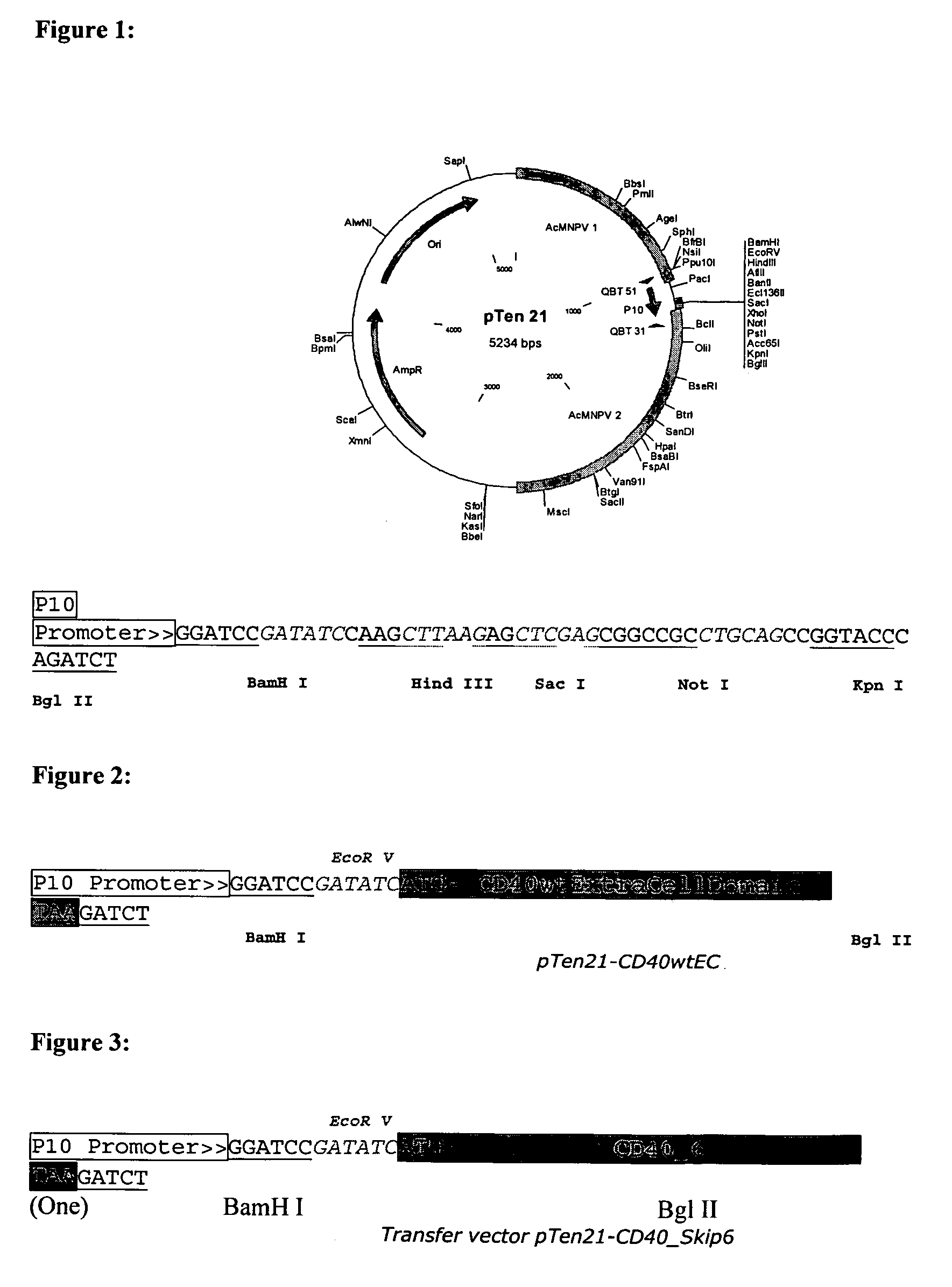CD40 splice variants and their uses
a splice variant and polypeptide technology, applied in the field of splice variant polypeptides, can solve the problems of varying appearance of many, thromboembolic complications, and the exact mechanism through which this blockade inhibits the rejection of transplanted tissue, so as to improve the accuracy of hybridization assays and increase the detection sensitivity
- Summary
- Abstract
- Description
- Claims
- Application Information
AI Technical Summary
Benefits of technology
Problems solved by technology
Method used
Image
Examples
example 1
Production of Skip 6 Polyclonal Antibody
Rabbits were Immunized with KLH Conjugated 95% Purified 15aa Peptide (ESPGGDPHHLRDPVC, SEQ ID NO: 3) taken from the Unique Tail of Skip 6 Variant (SEQ ID NO: 24).
[0361] The anti-CD40-skipping 6 antibodies were then purified from rabbit serum by ammonium sulfate precipitation. Briefly, a saturated solution of ammonium sulfate was prepared by adding 380 gr to 500 ml water and boiling the solution. The serum was thawed and centrifuged at 10,000 rpm, 4° C. for 5 min. One vol. PBS was added to each vol. serum, and stirred at 4° C.
[0362] One volume of saturated ammonium sulfate was then added under stirring for at least 2 hours on ice. The solution was centrifuged 15 min. at 10,000 rpm at 4° C. to precipitate IgG. The pellet was resuspended in 5 ml PBS and dialyzed overnight at 4° C. against PBS+0.05% azide. The precipitated serum was filtered with a 0.45 μm filter.
[0363] Affinity purification was then performed with the peptide against which t...
example 2
Cloning of CD 40 Skipping6 Variant and the Wild Type CD40
[0377] For of all the constructed transfer vectors, the backbone was the pTen21 plasmid whose full-length sequence is given in SEQ ID NO:4. The plasmid map and its multiple cloning site sequences are given in FIG. 1:
I—Unfused Constructs:
[0378] 1—Construction of pTen21-CD40 wtEC Vector:
[0379] The CD40 wild type extracellular domain (CD40 wtEC) sequence was amplified by PCR using the following primers (the transmembrane domain of the wild type CD40 protein was excluded, therefore this CD40 wild type protein, upon translation, will be secreted).
(SEQ ID NO: 5)5′-ACTAgATATCATggT TCgTCTgCCTCTgCAgT-3′(Called 40wt5′)(SEQ ID NO: 6)5′-AAgCAgATCTTATCTCAgCCgATCCTgggg-3′(Called 40wt3′)
[0380] The PCR reaction was carried out using the ISIS DNA polymerase (Qbiogene Cat# EPSIS100).
[0381] The amplified fragment of about 600 bp was digested with EcoRV and BglII and ligated to pTen21 vector previously cut with the same enzymes to obtain...
example 3
Protein Production and Processing in Baculovirus Protein Production and Processing from 1 L volume of Baculovirus
[0398] Baculovirus cells were transfected with the above constructs (BacTen-CD40 wtEC-Fc, BacTen-CD40_Skip6-Fc, BacTen-CD40 wtEC and BacTen-CD40_Skip6, corresponding to pTen21-CD40 wtEC, pTen21-CD40_Skip6, pTen21-CD40 wtEC-Fc and pTen21-CD40_Skip6-Fc, respectively), and cultured to produce the expressed protein. The baculoviral culture conditions are described in table 1 below. The initial cell density, the MOI used and the harvesting time in each experiment are indicated in table 1. Where indicated in Table 1, the anti-protease treatment was applied in cell culture medium at the following final concentrations: Pepstatin 10 μM, Leupeptin 2 μM, Pefabloc 1 mM. The final viability is indicated in Table 1 for each construct.
TABLE 1Culture conditionsAnti-Initial cellHarvestingProte-FinalConstructdensityMOITimeases*ViabilityBacTen-˜800.000 / ml272 hpi−85%CD40wtEC-FcBacTen-˜800...
PUM
| Property | Measurement | Unit |
|---|---|---|
| thickness | aaaaa | aaaaa |
| size | aaaaa | aaaaa |
| pore size | aaaaa | aaaaa |
Abstract
Description
Claims
Application Information
 Login to View More
Login to View More - R&D
- Intellectual Property
- Life Sciences
- Materials
- Tech Scout
- Unparalleled Data Quality
- Higher Quality Content
- 60% Fewer Hallucinations
Browse by: Latest US Patents, China's latest patents, Technical Efficacy Thesaurus, Application Domain, Technology Topic, Popular Technical Reports.
© 2025 PatSnap. All rights reserved.Legal|Privacy policy|Modern Slavery Act Transparency Statement|Sitemap|About US| Contact US: help@patsnap.com



